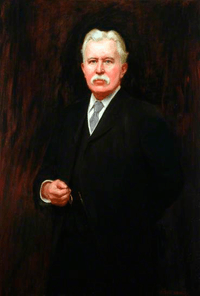John Aspinall (engineer)
| Sir John Aspinall | |
|---|---|
|
by George Hall Neale c.1920 | |
| Born | 25 August 1851 |
| Died | 19 January 1937 (aged 85) |
|
Engineering career | |
| Discipline | Civil, Mechanical |
| Institutions | Institution of Civil Engineers (president), Institution of Mechanical Engineers (president) |
Sir John Audley Frederick Aspinall (25 August 1851 – 19 January 1937) was a British mechanical engineer who served as Locomotive Superintendent of the Great Southern and Western and Lancashire and Yorkshire Railways. He introduced vacuum brakes to his locomotives in Ireland, a trend which was followed in Britain, and designed several locomotives. He was also president of the Institution of Mechanical Engineers and of the Institution of Civil Engineers.
Biography
Aspinall was born on 25 August 1851 in Liverpool to a Roman Catholic judge.[1][2] He attended the Roman Catholic boarding school of Beaumont College, Berkshire before being apprenticed to engineers John Ramsbottom and Francis Webb of the London and North Western Railway in 1868.[1][2] He was sent by Webb to the United States of America in 1872 where he was greatly impressed by the larger loading gauge in use there.[1] In 1875 he moved to the Great Southern and Western Railway of Ireland and became their works manager at Inchicore, Dublin.[2] Aspinall was promoted to Locomotive Superintendent in 1882 and introduced a form of vacuum braking to his locomotives which was soon adopted by several other lines, including the London and North Western and Great Northern Railways.[1]
He became the Chief Mechanical Engineer of the Lancashire and Yorkshire Railway in 1886 and their general manager in 1899.[2] In this capacity he introduced electrification and greatly expanded the transport of coal.[1] He was promoted to Locomotive Superintendent in 1883 and, continuing the work of his predecessor, William Barton Wright, he modernised the locomotive stock, bringing in several of his own design.[1] Aspinall served as president of the Institution of Mechanical Engineers between 1909 and 1910 and was interned in Germany at the outbreak of the First World War in 1914.[1] Aspinall received a knighthood on 13 June 1917 for his contributions to the war effort and national transport system.[2][3] He served as president of the Institution of Civil Engineers between November 1918 and November 1919.[4] He was the first recipient of the Institution of Mechanical Engineers' James Watt International Medal, receiving it in 1937.[5] He died on 19 January 1937.[1]
He wrote seven academic papers and was the holder of fourteen patents.[1]
Locomotive designs
- L&YR Class 2 and Class 3, two designs of 4-4-0 steam locomotive.
- L&YR Class 5, a class of 270 steam tank locomotives with a 2-4-2T wheel arrangement.
- L&YR Class 7, a class of 40 steam passenger locomotives built between 1899 and 1902 with a 4-4-2 wheel arrangement.
- L&YR Class 21, class of small 0-4-0ST steam locomotives for shunting duties.
- L&YR Class 23, a class of 0-6-0ST steam locomotive used for shunting and for short-trip freight working, originally by William Barton Wright, rebuilt by Aspinall.
- L&YR Class 27, a class of 0-6-0 steam locomotive designed for freight work.
- L&YR Class 30, a class of 0-8-0 steam locomotives, designed by Aspinall, built under Hoy.
See also
References
- 1 2 3 4 5 6 7 8 9 Steam Index. "Biography of Sir John Aspinall". Retrieved 2008-05-24.
- 1 2 3 4 5 Science and Society Picture Library. "Brief Biography of Sir John Aspinall". Retrieved 2008-05-24.
- ↑ The London Gazette: no. 30138. p. 6047. 19 June 1917. Retrieved 2008-05-24.
- ↑ Watson, Garth (1988). The Civils. London: Thomas Telford Ltd. p. 252. ISBN 0-7277-0392-7.
- ↑ Institution of Mechanical Engineers. "James Watt International Medal Recipients" (pdf). Retrieved 2008-05-24. Archived March 19, 2009, at the Wayback Machine.
| Professional and academic associations | ||
|---|---|---|
| Preceded by Tom Hurry Riches |
President of the Institution of Mechanical Engineers 1909–1910 |
Succeeded by Edward B. Ellington |
| Preceded by Harry Edward Jones |
President of the Institution of Civil Engineers November 1918 – November 1919 |
Succeeded by John Griffith |
| Business positions | ||
| Preceded by Locomotive Superintendent of the Lancashire and Yorkshire Railway W. Barton Wright |
Chief Mechanical Engineer of the Lancashire and Yorkshire Railway 1886–1899 |
Succeeded by Henry Hoy |
